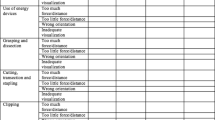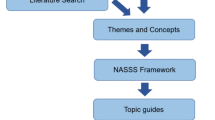Abstract
This paper describes a set of studies that use audio–visual recording in an actual environment (surgery) to study the effectiveness of various patient safety interventions. Video is used in several different ways: as the intervention in one of the studies, and as a means to capture team behavior during surgeries for the other two studies. This paper summarises the logistical, legal, regulatory, technical, financial, social and methodological factors that must be considered and discusses solutions to many of these potential barriers. Although audio–visual recording has a long history in human factors research, only now are the technical, financial and logistic barriers less of a concern, as all data can now be stored and analysed electronically, making many previously cumbersome factors less so through the use of technology. Perhaps the most challenging areas that require more research are the methodological difficulties encountered when observing teams in an uncontrolled environment.
Similar content being viewed by others
Explore related subjects
Discover the latest articles, news and stories from top researchers in related subjects.Notes
Microphones are attached to the surgeons after they have scrubbed. We put the microphone receiver in the subject’s back pocket, attach the microphone to the shirt just over the shoulder, and tape the microphone wire to the shirt on the back using surgical tape. Surgeons and the scrub nurse then put their gown on over this, whereas the rest of the staff are not required to be scrubbed and gowned.
References
Calland J, Guerlain S, Adams R, Tribble C, Foley E, Chekan E (2002) A systems approach to surgical safety. Surg Endosc 16(6):1005–1014
Gaba DM, Howard SK, Flanagan B, Smith BE, Fish KJ, Botney R (1998) Assessment of clinical performance during simulated crises using both technical and behavioral ratings. Anesthesiology 89(1):8–18
Gawande AA, Thomas EJ, Zinner MJ, Brennan TA (1999) The incidence and nature of surgical adverse events in Colorado and Utah in 1992. Surgery 126:66–75
Green KB, Luniewski M, Mersch T, Mitchell B, Poole GR, Guerlain S, Adams R, Calland JF, Chekan E (2002) Video-based training for laparoscopic surgery. In: IEEE systems and information design symposium, Charlottesville, VA, April 2002, pp 103–109
Guerlain S, Shin T, Guo H, Calland JF (2002) Team performance data capture and analysis system. In: Proceedings of the human factors and ergonomics society 46th annual meeting, Baltimore, MD, 30 September-4 October 2002
Held J, Bruesch M, Krueger H, Pasch T (1999) The FIT-system: a new hand-held computer tool for ergonomic assessment. Med Biol Eng Comput 37(Suppl. 2):862–863
Leape LL, Brennan TA, Laird N, Lawthers AG, Localio AR, Barnes BA, Hebert L, Newhouse JP, Weiler PC, Hiatt H (1991) The nature of adverse events in hospitalized patients. Results of the Harvard medical practice study II. N Engl J Med 324:377–384
Leape L (1994) The preventability of medical injury. In: Bogner M (ed) Human error in medicine. Lawrence Erlbaum Associates, Hillsdale, NJ, pp 13–25
National Institutes of Health (2003) Certificates of confidentiality kiosk. http://grants1.nih.gov/grants/policy/coc/. Cited 13 Sept 2003
Shin T (2003) Team performance measurement: measuring inter-rater reliability/agreement of independent team scores. Master’s Thesis, University of Virginia
Acknowledgements
R. Scott Jones M.D. provided invaluable support for getting this work started. The RATE software was developed by Thomas Shin, a graduate student in the Department of Systems and Information Engineering at the University of Virginia. Special thanks to Hui Guo, graduate student in Systems and Information Engineering, for his contributions to the technical process and to Viktor Bovbjerg, assistant professor in Health Evaluation Sciences, for his critical insights into study designs and data analysis. Systems Engineering undergraduates K. Brook Green, Maranda Luniewski, Todd Mersch, Brian Mitchell and G. Reed Poole conducted the perceptual training module study as a senior design project, with technical guidance from Edward G. Chekan. We also acknowledge and thank the Dynamics Research Corporation for sharing their video training tapes and the United States Air Force for sharing their Medical Team Management program. This material is based upon work supported by the National Science Foundation under Grant No. 0092985 (SG), the National Patient Safety Foundation (RA, JFC and SG), and Karl Storz Endoscopy of America (RA and JFC). Any opinions, findings and conclusions or recommendations expressed in this material are those of the authors and do not necessarily reflect the views of the National Science Foundation, the National Patient Safety Foundation, or Karl Storz Endoscopy of America.
Author information
Authors and Affiliations
Corresponding author
Rights and permissions
About this article
Cite this article
Guerlain, S., Turrentine, B., Adams, R. et al. Using video data for the analysis and training of medical personnel. Cogn Tech Work 6, 131–138 (2004). https://doi.org/10.1007/s10111-004-0154-2
Received:
Accepted:
Published:
Issue Date:
DOI: https://doi.org/10.1007/s10111-004-0154-2




